Intel at MWC 2015: SoFIA, Rockchip, Low Cost Integrated LTE, Atom Renaming and 14nm Cherry Trail
by Ian Cutress on March 2, 2015 9:00 AM EST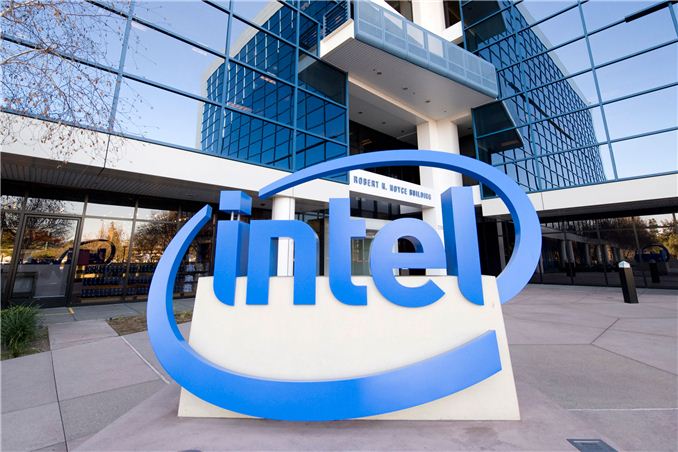
After day zero at Mobile World Congress already boasting some impressive releases, Intel tackles their platform on day one on several different fronts. As part of a pre-briefing, we were invited into the presentation where Intel discussed the current state of their mobile portfolio along with looking to the future. The pre-briefing was run by Aicha Evans, Corporate Vice President and General Manager of the Wireless Platform Research and Development Group, who you may remember was interviewed by Anand in a series of videos back in 2013. Ms. Evans' focus stems on the connectivity side of the equation, making sure that Intel’s portfolio develops into a strong base for future platforms.
One of the big elements for Intel is the rebranding of their mobile Atom line of SoCs. Up until this point, all the SoCs were difficult to follow and very similar names such as Z3580 or Z3760. This is adjusted into three different segments as follows:
Similar to their personal computing processor line, the Intel Atom structure will take on x3/x5/x7 naming, similar to the i3/i5/i7 of the desktop and notebook space. This is not to be confused with Qualcomm’s modem naming scheme, or anything by BMW.
The x3 sits at the bottom, and is comprised of Bay Trail based SoCs at the 28nm node all previously part of the SoFIA program aimed at emerging markets. There will be three x3 parts – a dual core x3, a quad core x3 from the Rockchip agreement, and a final quad core x3 with an integrated LTE modem.
This set raises some interesting points to discuss. Firstly is the use of 28nm is the same node as previous Intel Atoms, and thus should be derived from a TSMC source. It is also poignant to note that for these SoCs Intel is using a Mali GPU rather than the Gen 8 graphics and their own IP. This is due to the SoFIA program being aimed at bringing costs down and functionality into the low price points in a competitive time-to-market.
The Rockchip model, indicated by the ‘RK’ at the end of the name of the SoC, comes from the partnership with Rockchip we reported on back in May 2014. At the time Intel discussed the roadmap for producing a quad core SoC with 3G for the China market in the middle of 2015, which this provides.
The final part of the x3 arrangement revolves combining a 5-mode LTE modem on the same die. Intel is going to support 14 LTE bands on a single SoC with PMIC, WiFi and geolocation technologies (GPS, GLONASS, BeiDou).
The Atom x5 and x7 SoCs represent the next step up, implementing Intel’s 14nm process and bringing Cherry Trail to market. The x5 and x7 SoCs are aimed primarily at tablets, but can find their way into sub 10.1 inch tablets as well, providing an interesting counterbalance to the high price premium of Intel Core-M 4.5W products based on Broadwell-Y. While the x3 line will focus first on Android moving into Windows, x5 and x7 is designed to be targeting both, particularly with the bundled Gen 8 graphics and LTE with XMM276x supporting Cat-6 and carrier aggregation.
Not a lot of detail was provided about x5 and x7, suggesting that they are aimed more at late 1H/2H 2015 down the line. This coincides with the next generation of Intel’s XMM 7360 modem, featuring up to 450 Mbps downlink and support for up to 29 LTE bands.
One interesting element in the x5/x7 scenario was the bundled platform block diagram provided by Intel, showing clearly the two dual-core Airmont CPUs each with 1MB of L2 cache, Gen 8 graphics, separate security processors and ISP, as well as USB 3.0 support.
Finally, Intel addressed the obvious lack of a high-end mobile SoC that fits into the performance smartphone category. Intel is still working on development of such a SoC in the form of Braxton and we'll have more news on this piece in the future.
We are lining up a chance to interview Ms. Evans about Intel’s Atom lineup later this week at MWC, so stay tuned for that.


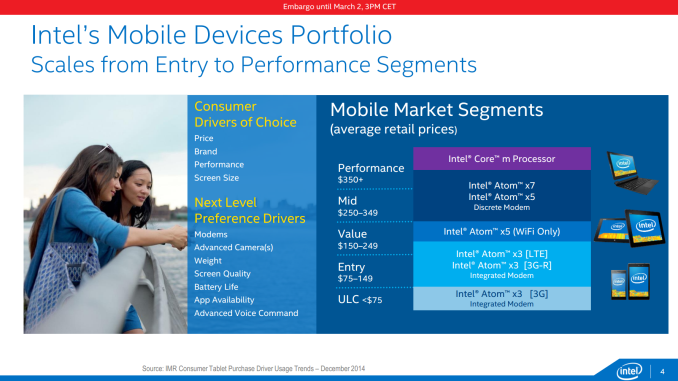

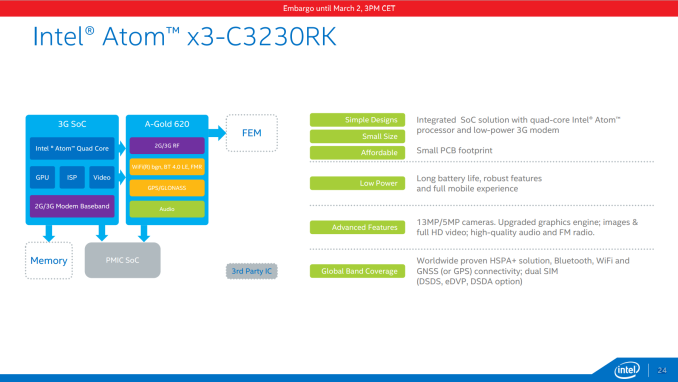
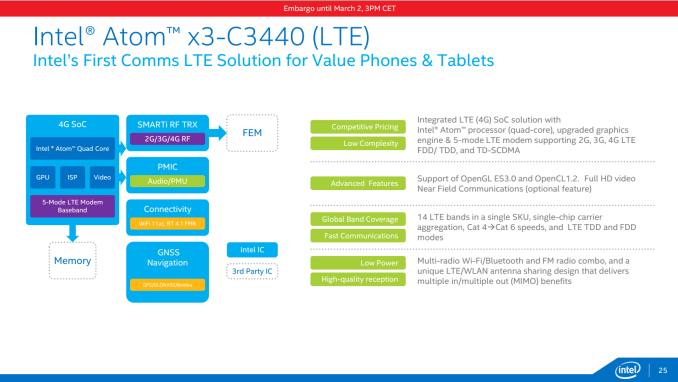
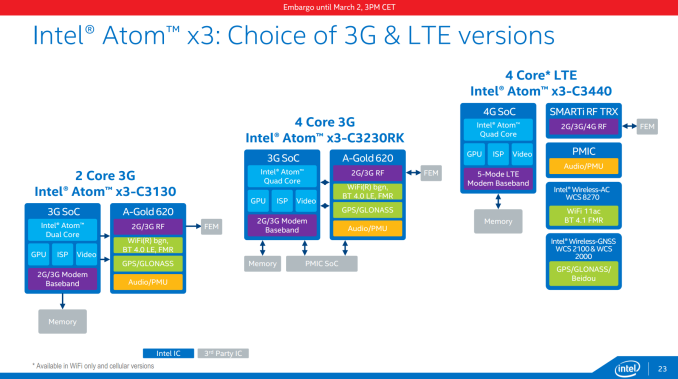
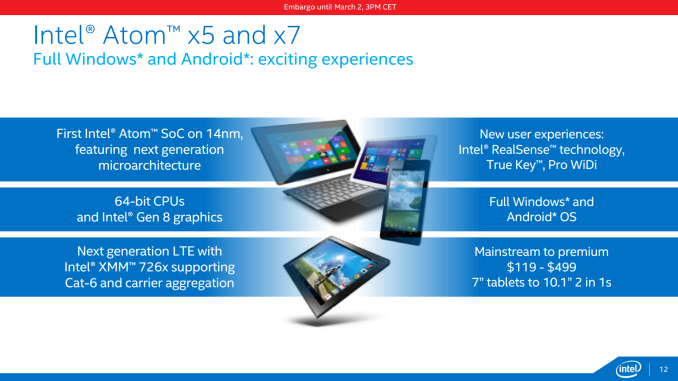
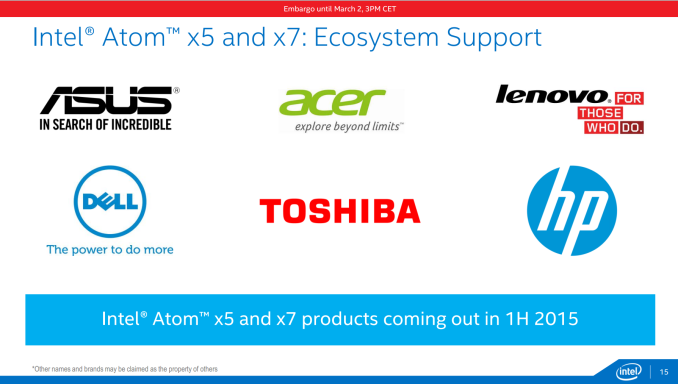
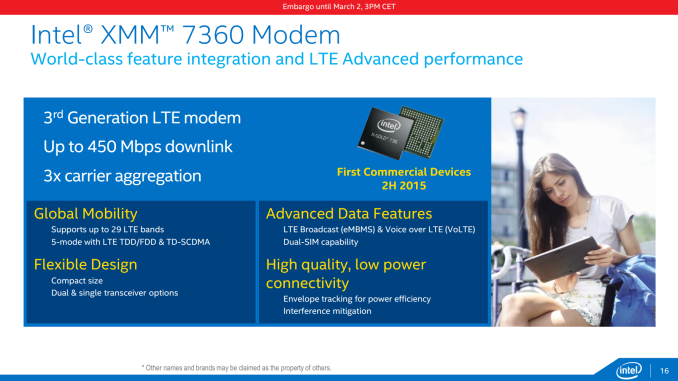









37 Comments
View All Comments
CiccioB - Monday, March 2, 2015 - link
If it produced on 28nm TMSC it is surely an ARM core then, not a x86. I don't think than Intel is ever going to allow for a production of x86 chips outside its foundries and most of all, there was not enough time to convert a x86 core to a TMSC PP.Of all of this, I would like to know what Intel IP are in there but the name.
rootheday3 - Monday, March 2, 2015 - link
For sure these are using Intel IP - silvermont cpu, intel modem, ... The only external IP that is announced so far is Mali GPU.Yes, it seems off that Intel is dabbing soc at TSMC , but this was clearly explained in earlier interviews- porting the modem to intel 14nm was harder than porting intel cpu to 28nm. This is continuation of intel WPRD feature phones from previous Infineon which was manufactured at TSMC. Intel had been manufacturing discrete 3G and LTE modems has been at TSMC for as while.
Intel will be moving modem on to Intel 14nm this year for products next year.
Exophase - Monday, March 2, 2015 - link
While there may not be other external IP announced, I doubt they teamed up with Rockchip if the GPU was the only foreign part.CiccioB - Tuesday, March 3, 2015 - link
Sorry, it is not clear if the core are x86 or ARM based for x3 series. If the latter there's nothing but the modem as Intel IP in those SoCs.JumpingJack - Monday, March 2, 2015 - link
Indeed. Bay Trail was all 22 nm within Intel's fabs. It appears SoFIA will be fabbed elsewhere as many other sites are reporting it to be 28 nm -- Intel does not run a 28 nm process, unless it is top secret and not mentioned anywhere. Most likely being made with TSMC.CiccioB - Tuesday, March 3, 2015 - link
Usually many hints make a proof...It is manifactured outside Intel's fabs
It' s on a different nanometry and PP in general (which is surely not better than those provided lately by Intel in terms of quality)
It has been created quite soon (so doubts may raise on proprer x86->28nm TMSC PP port)
It uses an ARM based IP for GPU (not even a PowerVR as previous Atoms)
It seems to me that all these x3 are simply ARM SoCs made by RockChip with an Intel label on them.
We know Intel can't compete in term of costs with chinese (but probably all) ARM SoCs.
And we know that on the same PP Atoms can't compete in terms of perf/watt.
If these x3 are really x86 based, we have a combination of the worst of the two cases above: worse PP and a x86 architetcure. How can these SoCs compete with very cheap and low power Cortex-A7 SoCs?
V900 - Wednesday, March 4, 2015 - link
Nonsense...It's obviously an x86 CPU... Otherwise why would Intel be involved at all? To sell their awesome modems?!?
It's made with TSMC because of price and Intels own 14nm/22nm being busy with Broadwell. In this segment price is the most important factor, so the fact that Intels own fans could make a higher performing chip means little.
That the GPU came from ARM is as insignificant as the fact that one of their old Atom GPUs came from Power VR. They chose ARMs Mali GPU because their own 5000-series GPU is too big, too fast and too powerhungry for this market. ARM's Mali solution fit Intels performance and price metrics, it's as simple as that.
CiccioB - Wednesday, March 4, 2015 - link
So I ask again, if it is x86, what's the contribution of Rockchip to it? Intel already knows how to make an Atom with PowerVR. Building it at 28nm may be cheaper than using its own 22nm, but surely not at 32nm. And seen all the fuss about the 32nm Intel quality against competing 28nm, Intel (od and now cheap) 32nm should still perform better than TMSC PP. Without speaking about the fact that producing a x86 core outside its foundries exposes its architectural secrets to the rest of the market.Then, he fact that the chip is restricted to Asian market (probably because in cheap Chinese product sponsorized by Rockchip itself) still raises more than eyebrow.
djvita - Monday, March 2, 2015 - link
will the x5/7 support more than 2Gb RAM? if not, i'm keeping my venue 8 pro for longer....better to save for a surface in that casekyuu - Monday, March 2, 2015 - link
For some reason this article doesn't show the slide that details the x5/x7 specifications. Link here: http://cdn.arstechnica.net/wp-content/uploads/2015...Basically, the low-end x5 only supports up to 2GB of RAM, but the higher end x5 and the x7 model both support up to 8GB. Hopefully we only see higher-end x5 and x7 models in OEM designs.